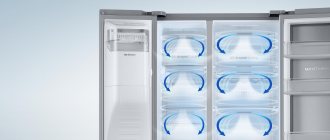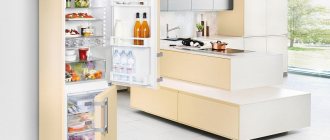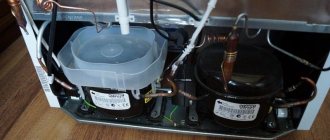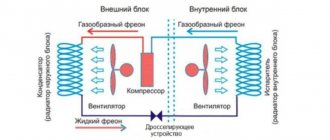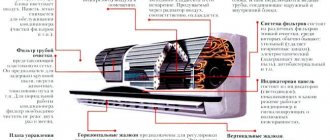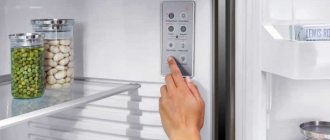Modern refrigerators have one of two automatic defrosting systems: drip and No Frost, which means “without frost.” Each of them has its own advantages and disadvantages. Let's figure it out: know frost or drip refrigerator: which is better in order to make the right choice when purchasing.
Difference between drip and No Frost refrigerator
Among people who are not very well versed in refrigeration technology, there is an opinion that the drip system is much worse than No Frost. That in such refrigerators the ice freezes at a terrible speed and that they need to be defrosted very often. Actually this is not true. Most modern refrigerators have high-quality insulation of the chambers; the doors fit tightly to the body thanks to multi-circuit seals. Therefore, almost no ice is formed inside with any of these systems.
We can briefly imagine the advantages of each of them.
| Drip | No Frost |
| Cheaper | Less hassle with care |
| More useful volume | Recovers temperature faster after defrosting |
| Consumes less energy | The cold spreads evenly throughout the chamber |
| Works quietly | Quick freezing |
| More models available | No condensation on the back wall |
Which is better No Frost or a drip system in the refrigerator
Let's look at the advantages and disadvantages of both systems:
Drip refrigerators | |
| Advantages: | Flaws: |
|
|
Refrigerators No Frost | |
| Advantages | Flaws |
|
|
Drip system
The drip defrosting system is the most common. It consists of the following main components:
- Engine with compressor
- A condenser in the form of a coil through which the refrigerant moves
- Capillary tube - the place where gas turns into liquid
- An evaporator located inside the housing that cools the chambers
- Temperature control relay
All these parts are hidden behind a plastic casing, so they are not visible in the camera and do not take up extra space.
Operating principle of a refrigerator with a drip system
In refrigerators with a drip cooling system, moisture collects on the back wall, from where it gradually flows into a special container. Under the influence of the evaporator, droplets are removed from the chamber.
It goes like this:
- When operating, the compressor increases the pressure of the refrigerant gas
- The gas enters the capillary tube and condenses, turning into a liquid there
- It enters the evaporator and takes heat from the chamber
- When heated, the refrigerant boils and turns into a gaseous state.
Let's see what's happening in the cell at this time. The moisture is distributed evenly there. When the compressor turns on and starts to cool the back wall, it collects on it and turns into frost. When the compressor stops, having created the required pressure, the frost begins to thaw. The water runs down through the drainage hole into a container located above the compressor. When it heats up, the moisture evaporates out.
Automatic defrosting system "No Frost"
“No Frost” (aka No-Frost) is the latest technology for protecting against the appearance of ice and condensation of water vapor on the walls of the refrigeration compartment. True, it is based on the same classical physical laws.
“No-Frost” involves mixing the air inside the working chamber of the device. To do this, a fan is installed on one of the walls, which, when rotated, ensures convection of the masses. As a result, moisture condensation points do not form on the walls, droplets do not appear and do not freeze.
No Frost technology appeared in refrigerators relatively recently, just a few years ago. To this day, household appliances equipped with this particular method of anti-icing belong to the middle or premium price segment. This is explained not only by the structural complexity of the device, but also by the need to protect the fan from premature wear or short circuit.
The fact is that standard coolers are not suitable for use in a humid environment - which, moreover, may contain volatile fats. They quickly become clogged with contaminants and burn out. Therefore, special fans are installed in refrigerators that are protected from such damage, often moving the electric motor outside the working compartment.
The fan itself, as a rule, operates at low speeds. Its task is to ensure convection of air masses, and not to cool products. Classic freon copes well with the latter. Therefore, the noise from the blades is practically inaudible, and the energy consumption increases so slightly that this can be completely neglected when calculating the consumption of kilowatt-hours.
Advantages of No Frost refrigerators:
- High sanitary cleanliness. Moisture does not accumulate anywhere, does not mold and does not become a source of microbes. This is especially important for people with sensitive digestion, respiratory diseases such as asthma or a tendency to allergies;
- No drying effect on products. Ready-made dishes can be placed in containers without a lid, since moisture from their surface practically does not evaporate. Thanks to this, even products such as fish or meat are not covered with an unpleasant dry “crust”;
- Uniform temperature distribution. There are no colder or warmer parts inside the chamber - unless, of course, they are provided, which can also be called “zero”).
Disadvantages of No Frost refrigerators:
- Relatively high price. Such household appliances are more expensive than analogues with other systems for preventing chamber icing;
- Unpredictable operating period. If used incorrectly, the convection fan may fail, after which urgent repair of the equipment will be required.
The main rule for operating refrigerators with No-Frost defrosting is not to place actively evaporating products in them. A pan of hot, still “smoking” soup may well damage the fan or simply reduce its durability. In general, liquid products in such refrigerators are best placed in closed, airtight containers.
Refrigerators with No Frost system
The No Frost defrosting system is more prestigious than drip defrosting. Its essence is that the moisture accelerated by the fan does not have time to turn into frost or ice in the chamber. It is brought out through a system of passages in the rear and side walls. There is an evaporator, a built-in heating element and a drainage system through which moisture passes.
The principle of operation of a refrigerator with a No Frost system
The refrigerant is compressed to a liquid state under the influence of a compressor and begins to absorb heat. Fans distribute cold air throughout the chamber and the system of passages in the walls. As a result, the temperature in the center and all corners is equalized, the products are cooled or frozen evenly. Moisture in the air leaves the wall and condenses on the evaporator coil.
After a certain time, the heating element starts. Under its influence, the ice thaws and water flows through the drainage system into a container on the compressor. It evaporates out. Therefore, the chamber walls always remain dry.
Advantages
The No Frost system has the following advantages:
- Ice and frost do not form in the chamber, so it can not be defrosted for several years. But manufacturers recommend doing this at least once a year for hygiene purposes.
- The walls of the chamber are always dry
- Bacteria do not collect inside due to normal humidity levels
- Uniform temperature is maintained in all corners of the chamber
Flaws
No Frost also has disadvantages:
- The system has more units, so the likelihood of breakdown increases
- Repairs are more expensive than for a drip system
- Products can only be stored in closed containers. When open, they quickly ventilate due to the regular inclusion of the fan.
- Fans make additional noise. This is especially true for budget models
- Noise level 36-47 dB
Features of operation of refrigerators with no frost and drip system
Today there are many models of refrigerators on the market to suit every taste and need. The differences between modifications can be both very serious and insignificant.
Refrigerated cabinets may differ in internal filling:
- number of autonomous freezers;
- way of organizing space - shelves or containers;
- The material used to make the separation compartments is plastic or glass.
In addition, refrigerators are distinguished by:
- size and external color scheme;
- number of operating compressors;
- availability of additional useful options.
However, there are other factors to consider when choosing a freezing system.
Easy to care for
As mentioned above, refrigerators with a drip defrosting system need to be turned off periodically to defrost ice from the back wall. In addition, it is not recommended to place food in the freezer close to the back wall. After all, no one will like the prospect of peeling off the ice from a grocery bag in the future.
Periodic defrosting is mandatory for drip refrigerators
From the point of view of saving time and effort of the user, the No Frost system is more preferable. This is because there is no need to wait for it to thaw and remove ice from the freezer yourself.
Attention! Under no circumstances should you peel the ice from the walls of the case and rub the surface with an iron sponge. Abrasive products are completely avoided when cleaning your refrigerator.
Energy class
Due to the continuous operation of the fan unit, refrigerators with dry mode consume more electricity. Optionally, they are better equipped and each additional feature, for example, an audible door open indicator, also requires energy consumption.
Refrigerator energy consumption classes
Noise level
The same ventilation unit produces quite a lot of noise during operation. That is why dry freeze refrigerators deservedly enjoy the reputation of being quite noisy units.
The refrigerator produces especially high decibels when the fans accelerate intensively immediately after closing the door.
Volume inside the refrigerator
The simple design of the cooling system of drip-type refrigerators frees up a large amount of usable space in the storage compartment and makes them more spacious.
It is worth noting that the need to maintain some distance from the back walls of the freezer makes this “merit” quite controversial.
The drip type has more usable area
Quality of food preservation
Intense air circulation in No Frost refrigerators has a negative effect on food and dries out their surface, evaporating natural moisture. In fairness, it is worth noting that a good housewife will never throw unwrapped food into the refrigerator. When wrapped, they retain their original appearance longer and do not spread odors throughout the entire area of the cabinet.
Products in a refrigerator with a drip system weather less. But berries and fruits are stored much better in dry air. Intensive ultra-fast freezing No Frost keeps frozen food safe and sound longer.
Ultra-fast freezing No Frost keeps food intact longer
Price
There is no clear answer to the question of what is better, the know frost or the “crying” system. It all depends on the preferences of the consumer and his financial capabilities. Each type of cooling has its own distinct advantages and disadvantages.
Attention! In this case, a very important rule applies - the latest models of any type of refrigerator have practically no differences in noise level. Modern fan noise suppression technology has made No Frost systems virtually inaudible.
Choose depending on your preferences and financial capabilities
At the same time, the old manual defrosting system is practically not used in “drip” models in the middle and higher price segments. The frost deposit in them is so small that it should not be taken into account. It can be removed quite easily and quickly with mandatory regular cleaning of the cabinet.
Most of the market is occupied by refrigerators with a wet freezing type due to their low cost due to the simplicity of the design of the cooling elements.
As a result, we can say:
- Drip refrigerators definitely benefit in price and significantly save the buyer’s budget;
- Units with dry freezing type are represented by fewer models;
- No Frost refrigerators produce more noise and consume more energy;
- The complex No Frost system requires expensive repairs by a qualified specialist in the event of a breakdown.
No Frost: myths and reality
A couple of decades ago, refrigerators with a No Frost defrosting system were much more progressive. Then the drip system could not ensure tightness inside the chambers due to the fact that the doors did not close tightly. Things look a little different now.
Unpleasant odors and rapid drying of food
Unpleasant odors do not form in a freezer equipped with a No Frost system, unless emergency defrosting occurs. In the refrigerator they can occur for the same reason or during storage of spoiled food. But the chances of this happening are less than with drip, because air exchange occurs faster and the temperature is equalized.
This type of refrigerator does not have a drain hole, so it cannot become clogged and cause unpleasant odors. Products in the refrigerator with No Frost quickly air out if stored uncovered. If you hide them in a container, there won't be much difference.
No Frost does not require defrosting at all
According to user stories, some of them do not defrost their refrigerator for 5-6 years. But it's not right. For the system to work properly, you need to remove food from it at least once a year, wash and wipe all surfaces.
Dry refrigerator is hazardous to health
From time to time, there are conversations on the Internet that the No Frost refrigerator is dangerous to health. This refers to the use of harmful substances as a refrigerant. Previously, outdated appliances used chlorofluorocarbon, which everyone knows as freon. After it was recognized as dangerous for the ozone layer, the cooling systems of refrigerators began to be filled with the inert gas tetrafluorocarbon R134a. Now many modern models use R600a.
The refrigerator, like any electrical appliance, including mobile phones, emits electromagnetic waves. But in modern devices they are tens of times less than in representatives of the last century. Just in case, it is better to install such a refrigerator at a distance of 1.5 m from the living area, and drip ones - 0.5 m. Since the refrigerator is rarely placed in the bedroom, it does not pose a significant danger.
There are no No Frosts with large chambers
Chambers with No Frost lose a lot of space due to additional equipment and air passages separated by a panel. In a chamber with a volume of 350 liters, only 300 liters will be useful. To get a large freezer, you need to buy a Side-by-Side refrigerator. The volume of chambers in the middle price class is 170-190 liters. Manufacturers Samsung, LIEBHERR, LG produce refrigerators with freezers from 260 to 290 liters.
No Frost system refrigerators are very noisy
It is believed that refrigerators with a No Frost defrosting system make more noise than appliances with a drip system. This occurs due to the fact that they use one or more fans that disperse air throughout the chamber.
Refrigerator No Frost
If you translate No Frost into Russian, you get “without frost.” This development appeared recently. It is most in demand in countries where humidity is constantly high. Its main difference from the “crying” system is the forced circulation of the air mass in the chamber of the device, thanks to the operation of a strong fan. A uniform temperature is created throughout the entire working space of the refrigerator. Air enters the cooler where condensation accumulates. After the compressor is turned off, the accumulated moisture flows through the chute into a special container.
Pros of No Frost refrigerators
- The temperature in the refrigerator compartment is always uniform. Therefore, you don’t have to worry about improper distribution of products. They will always be cooled equally.
- After opening the door, the temperature quickly returns.
- Food placed in the freezer freezes quickly. As a result, their beneficial properties are preserved as much as possible. Plastic bags never stick together.
- There is a slight accumulation of condensation inside the freezer compartment. It is also found in the area of the back wall.
- The device does not require defrosting.
Note! The refrigerator must be unplugged once a year. “Sanitation day” will allow you to maintain the necessary hygiene inside the product.
Cons of No Frost refrigerators
- Constantly circulating air gradually becomes dry. To increase humidity, it begins to attack poorly packaged foods. As a result, they dry out. Their appearance deteriorates and their taste changes. Therefore, long-term storage of products in such a unit is contraindicated.
- Complex design takes up internal space. The volume of the refrigerator decreases. Of course, this point can be compensated for by a large two-door device, but only if the kitchen is large in size.
- The cost of No Frost is much higher than its drip counterpart.
- High energy intensity. Operation requires large financial investments.
- Fans make a lot of noise.
Tips for choosing
Having compared the two automatic defrosting systems, we see that they both have their advantages and some disadvantages. Therefore, each buyer chooses a refrigerator for himself, taking into account his needs and other parameters: cost, size, minimum temperature in the freezer.
For many, a good option would be a device with a drip system installed in the refrigerator compartment and a No Frost system in the freezer. It will be cheaper than Full No Frost, but this will not affect functionality.
